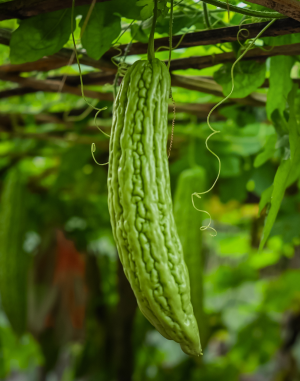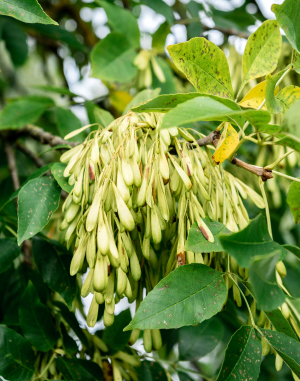Education
The content in the “education” section of the no-sweet.eu website is purely informational and educational in nature. It cannot replace consultation with a doctor or other specialists. The authors do not take responsibility for the use of advice and information contained on the website without consulting a specialist.

Bitter melon (Momordicae Fructus) is an annual plant that grows in tropical regions and is also known as balsam pear, bitter gourd, bitter squash, karela, karavella, and kathilla.
It acts as an insulin mimetic, meaning its consumption results in the regeneration of pancreatic beta cells and stimulates insulin secretion (4).
Research has shown that bitter melon can reduce the accumulation of body fat. This is due to its ability to stimulate lipid or fat breakdown while inhibiting the synthesis of fatty acids or triglycerides, making it a good choice for individuals planning to lose weight (5).
Compounds found in bitter melon activate the enzyme AMPK, which enhances metabolism and accelerates the burning of fatty acids – both of which are crucial elements in weight loss (4).
Triterpenoids present in bitter melon support glucose tolerance and fat absorption, preventing the accumulation of fat in the abdominal and thigh areas (5).
Bitter melon also regulates blood sugar levels, effectively protecting us from excess weight gain, as it is widely known that an excess of sugar largely contributes to obesity (4).

Gymnema sylvestre is a well-known plant in Ayurvedic medicine. It is also called “gurmar,” which in Hindi means “destroyer of sugar.” Among its components, it contains gymnemic acids, known for their anti-diabetic properties.
Gymnema significantly reduces the sensation of sweetness in foods containing sugar, blocks sweetness receptors in taste buds, and decreases the craving for sugar. It suppresses appetite (1). It supports weight control by maintaining a healthy level of appetite and reducing the caloric value of consumed food. It also helps maintain a normal blood glucose level. By inhibiting alpha-glucosidase, it hinders the breakdown of complex sugars into simple sugars in the digestive tract, thereby limiting their absorption (2).
In a study published in the journal “Diabetes, Obesity and Metabolism: A Journal of Pharmacology and Therapeutics,” individuals who took Gymnema sylvestre extract (GSE) showed a 5% reduction in body weight (3).

White mulberry (Morus alba) is a small deciduous tree from the Moraceae family. Its natural habitat is China, where the medicinal properties of mulberry have been utilized for many centuries. In Europe, white mulberry appeared in the 11th century and is now a commonly cultivated plant.
White mulberry suppresses appetite, particularly for sweets, by reducing the urge to snack. It also affects the inhibition of sugar absorption in the digestive tract by limiting the digestion of complex sugars. It counteracts the accumulation of fat tissue (6,7).

The European ash tree (Fraxinus excelsior) is found in most regions of Europe, from the Mediterranean Sea in the south to Norway in the north, and from the Caucasus to western Russia in the east. Ash is a large tree that can grow up to 40 meters tall. It is a long-lived tree with a typical lifespan of about 200 years, although some specimens can live to be over 500 years old. There is a rich historical tradition of using European ash as a medicinal remedy. Its use as a medicinal herb was already known to the ancient Greek physician Hippocrates (460-377 BC). St. Hildegard of Bingen (1098-1179), a German writer, composer, and philosopher, wrote about using parts of the tree to treat gout and rheumatism.
Extract from the seeds of European ash has an impact on reducing post-meal glucose levels and significantly reduces the amount of body fat. It significantly increases adiponectin levels, a protein synthesized by adipose tissue. This compound may influence appetite reduction and regulate metabolic processes. Therefore, adiponectin is associated with excessive body weight and can have a positive impact on glucose metabolism and insulin sensitivity (8).

Ginger (Zingiber officinale) is a perennial plant characterized by its green stems and green-yellow inflorescences. However, it is the root of the plant that is the most interesting, as this bulbous part of ginger has a very wide range of applications. Ginger is primarily cultivated in countries such as India, China, Nepal, Taiwan, Bangladesh, and Nigeria. Ginger contains compounds such as gingerols and shogaols, which are responsible for stimulating biological processes in the body when ginger is consumed.
Ginger supports the maintenance of normal blood glucose levels. It enhances post-meal satiety and aids in the reduction of stubborn abdominal fat. It also supports digestion. The use of ginger is also a way to curb excessive appetite. It has a regulatory effect on leptin levels (a protein secreted by adipocytes that plays a crucial role in regulating food intake and energy metabolism) (9,10).

Chinese lychee (Litchi chinensis), also known as litchi or lichee, is a species of tropical trees belonging to the soapberry family (Sapindaceae). It is the only representative of the Litchi genus. It originates from the region of Cambodia, Vietnam, and the Philippines but is cultivated in many warm-climate countries.
Extract from lychee seeds acts as a pancreatic lipase inhibitor, inhibiting the breakdown of triglycerides into simple fatty acids, which reduces fat absorption and leads to weight reduction. It operates using the same mechanism as a popular medication used in obesity treatment called orlistat (11,12). It also lowers blood glucose levels and exhibits anti-diabetic effects (13).

Vitamin B1 (thiamine) contributes to the maintenance of normal energy metabolism by enhancing the metabolic reactions of carbohydrates and amino acids, which can have an impact on reducing body fat and body weight. Thiamine directly influences carbohydrate metabolism, and its deficiency is strongly correlated with the prevalence of obesity in humans (14).

Common barberry (Berberis aristata), also known as European barberry, is a shrub often found in gardens as an ornamental plant. However, in addition to its attractive appearance, it possesses various health benefits.
Extract from the bark of barberry contributes to reducing insulin resistance and lowering blood sugar levels in individuals with type 2 diabetes. It has a positive impact on metabolism and helps maintain a normal cholesterol level, which contributes to weight reduction. Berberine works by accelerating the rate of fat tissue burning and increasing the feeling of fullness, as well as aiding the utilization of fats for energy needs. Berberine activates the enzyme AMPK, which plays a role in regulating the metabolic process. This substance also affects the secretion of hormones – leptin, insulin, and adiponectin – responsible for fat tissue formation and appetite regulation. Furthermore, berberine supports the use of energy substrates during physical activity and regulates hormones that influence fat storage. All these properties make berberine often referred to as an excellent “fat burner” (14,15). In a meta-analysis of multiple studies, berberine has been shown to be as effective as some oral anti-diabetic drugs like metformin and glipizide (16).

Black pepper (Piper nigrum) contains piperine, which has multiple effects on the digestive system. This alkaloid intensifies the processes of lipolysis, which is the breakdown of fat cells, facilitating weight loss. Additionally, higher doses of piperine lower triglyceride levels and the fraction of so-called “bad” LDL cholesterol while increasing the fraction of “good” HDL cholesterol (18).
According to recent research published in the Journal of Agricultural and Food Chemistry, piperine’s action involves its influence on the formation of new fat cells. Consequently, the positive effects of black pepper extracts in weight loss have gained another strong scientific foundation through these study findings (17).

Chromium (chromium picolinate), by regulating blood sugar levels, curbs ravenous hunger, reduces appetite, and diminishes appetide for sweets. It also accelerates the burning of fat tissue (19). Chromium supports weight loss efforts (20).
- https://www.researchgate.net/publication/313791573_Suppression_of_Oral_Sweet_Taste_Sensation_with_Gymnema_sylvestre_Affects_Postprandial_Gastrointestinal_Blood_Flow_and_Gastric_Emptying_in_Humans
- https://www.frontiersin.org/articles/10.3389/fphar.2017.00228/full
- https://dom-pubs.onlinelibrary.wiley.com/doi/10.1111/j.1462-8902.2004.00328.x
- https://www.ncbi.nlm.nih.gov/pmc/articles/PMC9000558/
- https://kulnaro.pl/gorzki-melon-odchudzanie-skuteczny-spalacz-tluszczu/
- White mulberry for weight loss – properties and effects (dimedic.eu)
- Anti-Obesity Effects of Morus alba L. and Aronia melanocarpa in a High-Fat Diet-Induced Obese C57BL/6J Mouse Model – PMC (nih.gov)
- A Fraxinus excelsior L. seeds/fruits extract benefits glucose homeostasis and adiposity related markers in elderly overweight/obese subjects: A longitudinal, randomized, crossover, double-blind, placebo-controlled nutritional intervention study – ScienceDirect
- https://www.tandfonline.com/doi/abs/10.1080/10408398.2018.1427044
- https://www.ncbi.nlm.nih.gov/pmc/articles/PMC5818945/
- https://pubs.rsc.org/en/content/articlelanding/2022/FO/D1FO03991A
- https://hrcak.srce.hr/file/319533
- https://www.ncbi.nlm.nih.gov/pmc/articles/PMC4352173/
- https://pubmed.ncbi.nlm.nih.gov/34956436/
- https://www.restartmed.com/berberine-weight-loss/
- https://www.ncbi.nlm.nih.gov/pmc/articles/PMC3478874/
- https://www.hindawi.com/journals/ecam/2022/6288742/
- https://pubmed.ncbi.nlm.nih.gov/21713094/#:~:text=Results%3A%20Supplementing%20piperine%20with%20HFD%20significantly%20reduced%20not,HDL%20levels%2C%20with%20no%20change%20in%20food%20intake.
- https://www.ncbi.nlm.nih.gov/pmc/articles/PMC2753428/
- https://academic.oup.com/nutritionreviews/article/56/9/266/1860507





